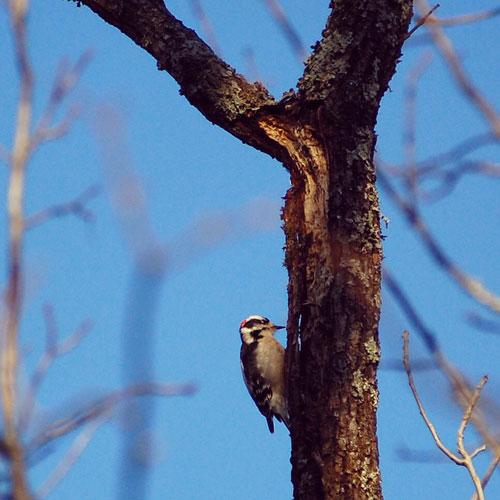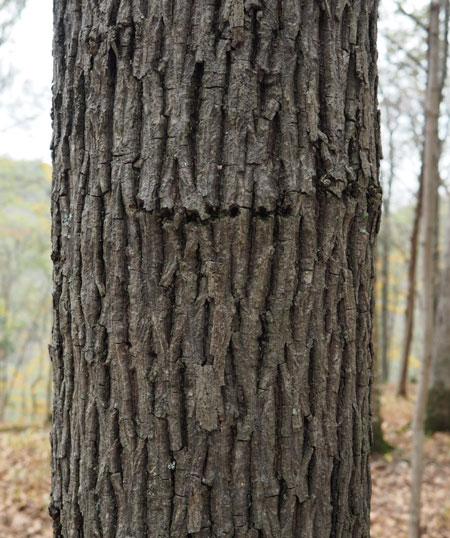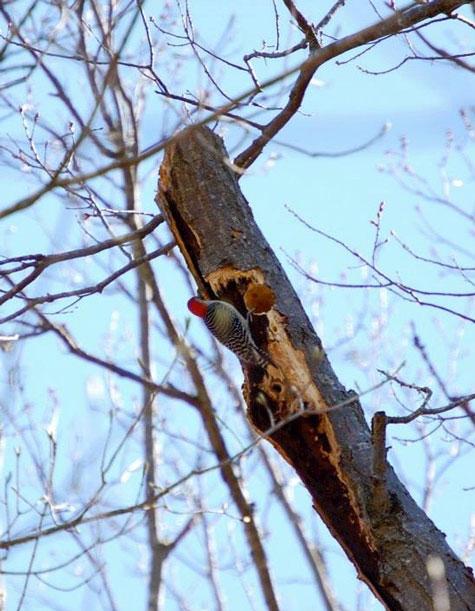Wildlife Connections: Tree Climbing Birds
By Beverly James

As migratory birds head south for the winter and the trees lose their leaves, there are a group of birds that become more noticeable this time of year - the tree climbers. This includes woodpeckers, nuthatches, and brown creepers. Most of them are year-round residents, but a few, such as the yellow-bellied sapsucker and the red-breasted nuthatch, are only observed here during the winter season. All of these birds have close relationships with the trees around us, where they spend much of their time foraging in and under the bark of mature trees and nesting in tree cavities. A large part of their diet consists of insects that can be injurious to trees, providing beneficial pest control.
Woodpeckers have bodies that are designed to climb up a tree and hammer into it. Their feet are zygodactyl, having two toes pointing forward and two pointing backward. A long, stiff tail gives them balance while maneuvering up a tree and their strong, sharp bills allow them to hammer away at the bark. Once they have created access to their food, they use their long, sticky tongue to grab it.
Kentucky is home to seven woodpecker species. Pileated and hairy woodpeckers prefer mature, deciduous forests, but other woodpeckers have adapted to urban parks and suburbs. Downy woodpeckers are the most commonly observed woodpecker in the Lexington area, foraging for beetle larvae, ants, and other insects. They are the smallest of our woodpeckers and have the agility to navigate smaller trees and branches. Yellow-bellied sapsuckers drill holes in characteristic rows, where they feed on the sap flowing from the trees and the insects attracted to the sap. In early spring, they will drill deeper holes to access the sap flowing upward in the xylem of a tree. Later in the season, the holes they drill become shallower as the sap is carried down through the phloem. Sapsuckers tend to prefer trees with higher sugar content such as maples, hickories, and birches. While they can damage healthy trees, they will often target wounded trees.

Nuthatches stand out from woodpeckers, often working their way down a tree trunk and taking advantage of the crevices the woodpeckers miss. They have anisodactyl feet with three toes in the front and one very long toe in the back that allows them to travel head first down a tree. Their necks do not have the strength of the woodpeckers, but their long, straight bills allow them to probe into various nooks, feeding on beetle larvae, tree hoppers, scale insects, ants, and caterpillars. They will also feed on nuts and seeds, which they will anchor into a bark crevice so they can hammer them open with their bills. Nuthatches prefer mature woods, but can be found in wooded urban areas.
Brown creepers may be the most difficult of these birds to spot due to their brown streaky appearance that blends well with tree bark. When seen, they are often moving up and around a tree trunk, starting near the bottom of a tree and working their way up until they fly off to the bottom of another nearby tree. Their long, curved bill probes into loose or deeply furrowed bark, where they meticulously feed on beetles, bugs, leaf hoppers, scale insects, sawflies, and more. Like woodpeckers, their long tail gives them additional support while climbing. Brown creepers arrive in this area in October and stay through early spring, delighting bird watchers throughout the winter months.

During the breeding season, woodpeckers and white-breasted nuthatches use trees in this area for their nest sites, particularly dead trees or dead parts of living trees. Woodpeckers will create nest cavities in areas where a fungus has softened the wood, making it easier to excavate. Nuthatches do not create cavities, but will use natural cavities or small nest sites abandoned by woodpeckers. Heavy pruning and the removal of dead wood reduces available nesting sites for these birds.
Citizen scientists have been contributing to population data on these and other birds for many years. During the winter months, there are two well established citizen science programs to participate in and see these birds in action. The Lexington area Christmas Bird Count will be held Saturday, December, 17th. Details will be shared through the Central Kentucky Audubon Society. The Great Backyard Bird Count will be held February 17-20, 2017 and you can participate as little or as much as you want from the comfort of your home.
Photography
- Downy woodpecker (B. James)
- Red-bellied woodpecker tending to a nest (B. James)
- Yellow-bellied sapsucker holes on a bitternut hickory (B. James)
About the Author
Beverly James is the Preserve Manager of Floracliff Nature Sanctuary, a 287-acre forest and ecological area in the palisades region of the Kentucky River in southern Fayette County. Email @ bjames@floracliff.org
